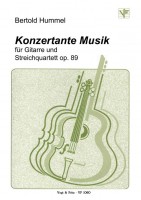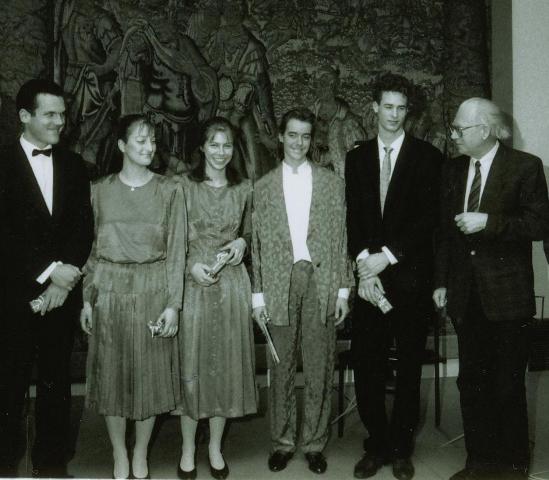Concertante Music for Guitar and String Quartet, op. 89a (1989)

I.
Andante ![]() beginning
beginning
II. Burlesque
III. Arioso
IV.
Finale ![]() beginning
beginning
Dedication: for Michael Tröster
First performance: March 11, 1990, Schweinfurt, Rathausdiele
Pia-Maria Grees / Susan Nesbet / Anne Christ / Duncan Emck / Adrian Jones

Duration: 23 Minutes
Publisher: Vogt & Fritz VF 1060 / ISMN M 2026-1283-5Errata: score and parts: III. Arioso, bar 32: last quarter pause omitted. IV. Finale: bar 16: guitar and violin parts must be exchanged.
In
the first movement, Andante, a twelve-tone theme is played above
a pedal-point g, initially by viola and violoncello. The guitar continues the
episode in a quasi recitative style. Above a pedal-point E (bar 11), the mirror
version enters; the theme is now with both violins. The guitar recitative also
takes the inverted form. In bar 21, the first four tones appear in closely following
entries; above the pedal-point A the twelve-tone theme joins on in the guitar,
leading to a chorale-like phase (bar 31) with F-sharp major tonality at the close.
The guitar enters again with the recitative idea. A repeat of the chorale episode
ends with B major. A series of triads (from bar 47), drawing on all the chromatic
material, signals the approaching end of the movement. The twelve-tone row (from
bar 54) appears for the last time and a completely chromatic sound results from
held notes in the strings.
The Burlesque (2nd movement) takes
the popular street-song "O, du lieber Augustin" as its starting point.
A turbulent sixteenth-note motion provides the necessary contrast to the metamorphoses
of the song, tonal clichés known to guitarists everywhere appear, only
to be swept away or subjected to sceptical questioning. Grandiose closing gestures
end the movement.
In the 3rd movement, Arioso sections, introduced
with baroque standard formulas, are separated, interrupted and closed by episodes
of static sound or of quasi recitative character.
The conclusion comes as
a concertante Finale with rondo character. A jazz-like theme over
pulsating basses contrasts with a somewhat grotesque march episode leading to
a cadenza for guitar. A kind of reprise follows with development of different
ideas from the 1st movement. The peaceful coda contains a surprising close.
Bertold Hummel

Schweinfurt, 11.03.1990
The
Concertante Music by Bertold Hummel shows signs of influence from
the Second Vienna School. The first movement of the work is clearly
determined by twelve-tone structures. A twelve-tone row is heard four times. Right
at the beginning, it is intoned in unison in viola and 'cello. After an intermediate
section for guitar, which, like the following interludes, loosely uses fragments
of the row, the basic row is entrusted to the high strings - in a new mode, however,
in inversion. A further interlude is heard, ending with a tremolo passage in the
strings. Now the guitar presents the row, transposing it initially from G
to A, then in new rhythmical guise to E. A final interlude, marked
by strong dynamic contrasts and closing once again with tremolo in the strings,
passes before the listener; then the row is put through its fourth exposition.
The individual tones of the twelve-tone melody are this time not in the charge
of a single instrument but wander through the all the parts involved, a procedure
already used by Anton Webern: see, for example, the final movement of his first
cantata.
To the strict architecture of the introductory Andante, the second
movement provides a sharp contrast, marked as it is by exuberant playing
and musical humour. The burlesque expression is strengthened not inconsiderably
by the quotations from the street-song "O, du lieber Augustin"
and its grotesque metamorphoses. Uniting himself in song with the world of "Augustin",
Hummel once again reveals his ties with the Vienna school. For Schoenberg also
bowed respectfully to the song from old Vienna and its hero when he quoted it
in his second string quartet.
The third movement of the Concertante
Music, entitled Arioso, also takes the form of a kind of journey into
the past. Spinning continuous threads of melody and with recurring touches of
counterpoint, he leads the listener into the Baroque.
Concluding, the Finale
has a rondo form. Dance-like passages, whose pulsating rhythms seem to be inspired
by vivacious South American music, join in effervescent contest, punctuated occasionally
by lyrical passages. The final word is granted to the dance-like element: after
some glissandos, traversing a seventh, it reappears for the last time -
in sublimated form, so to speak - in the harmonics of the guitar.
Matthias Henke